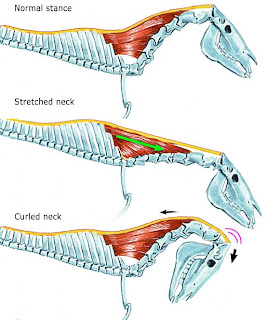It is clear that the horse is very well tamed and attentive to its rider. It can even be argued that the horse is supple. If the horse enjoys being ridden like this or not I leave up to you to decide for yourself. But why do I think this is unnecessary abuse? Why do I think it is not OK to have the horse behind the vertical in LDR?
This is what happens when the horse is asked to perform LDR:
*) The cervical ligaments are subjected to extreme and prolonged stretching, causing tearing of fibres (picture from ”Sustainable Dressage”).

*) The parotid glands are subjected to extreme compression which can cause inflammation.
*) The horse's field of vision becomes very limited. In LDR the horse can only see where it puts its feet, not what is in front of it.
*) The horse perceives gravity by the inner ear. There horses have a similar structure to humans with three semi circular canals that allow horses and humans to orient themselves in three dimensional space. It has been shown when humans are displaced from our natural reference positions for long periods of time balance disorders like sea sickness may occur. For horses in extreme situations like jumping or racing the natural reference positions corresponds to the head being 30o in front of the vertical.
*) The brachio-cephalic muscles that connect the head to the foreleg becomes shortened and contracted. This blocks the movement of the shoulders, which are also overloaded.
From ”Twisted truths of modern dressage” by Philippe Karl (2008)
FEI have not dared to forbid ”LDR” but stated that this training method should only be practised by professional riders. I leave it up to you to decide what you think of this training method. I know where I stand and I will not pay tribute to riders who ride like this, nor practice or teach this kind of riding. I think it is unnecessary abuse of the horse.
What do you think?
As usual, thanks to Mark Stanton of Natural Horsemanship Magazine for proof reading! Any remaining errors are all my own.






No comments:
Post a Comment